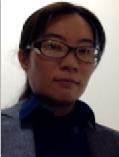Invited Speaker---Assistant Prof. Ikumi Suzuki

Department of Informatics and Electronics, Yamagata University, Japan
Biography: Ikumi Suzuki received a B.S. degree in Science from University of Tsukuba, Japan, in 2002, and M.S. degree in engineering from Nara Institute of Science and Technology in 2006. She received Ph.D in engineering from Nara Institute of Science and Technology in 2012.
She joined Center for Information Biology at National Institute of Genetics from 2012 April to 2015 March as a postdoctoral fellow. In 2015 April, she worked as a project researcher at Research Center for Statistical Machine Learning at The Institute of Statistical Mathematics in Tokyo. Since December 2015, she is working as an assistant professor at Department of Informatics and Electronics, Faculty of Engineering in Yamagata University.
Her current research focuses on machine learning, data mining, text mining and Information Retrieval. Especially, she is interested in data behavior in high-dimension. Her researches have been reported in prominent international conferences.
Speech Title: Elimination of Spatial Centrality; Hubness in High-Dimensional Problem and Its Reduction Method
Abstract: In this talk, I will present hubness phenomena which is known as one of the curse of dimensionality when dealing with nearest neighbor method in high-dimensional space.
While nearest neighbor can be a fundamental method for various type of machine learning and information retrieval methods, nearest neighbor is often affected by the samples which frequently appear in many other samples' neighbor. For intuitive explanation, the degree distribution of kNN graph skewed to the right, so that only some (hub) nodes has large number of edges.
Hubness is caused by high-dimensionality and spatial centrality. To mitigate the hubness influence on nearest neighbor, several hubness reduction methods have been proposed. Centering is probably one of the most simple and easiest way to adjust metric by eliminating spatial centrality to reduce hubness.
This talk will consist of three parts; part one is to briefly introduce hubness phenomena, part two is to explain how to reduce hubness and part three is to show how hubness influence on real applications, such as recommendation systems.